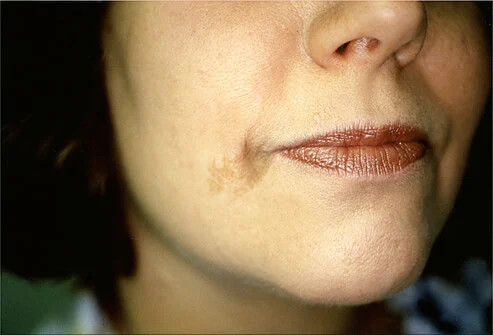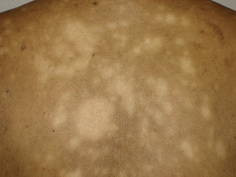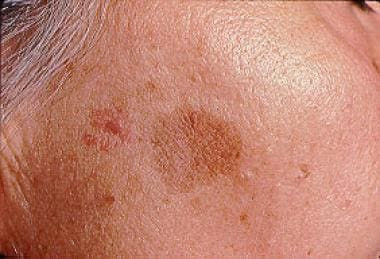Definisi
Café au lait merupakan kondisi kulit yang ditandai dengan adanya bercak datar dengan warna coklat muda atau coklat tua. Café au lait termasuk salah satu jenis tanda lahir pada kulit. Tanda ini dapat dikenali dengan mudah karena sering memiliki tepi yang tegas tetapi tidak beraturan, dan warnanya bervariasi, biasanya berwarna coklat muda tetapi bisa menjadi gelap dengan paparan sinar matahari terus-menerus. Ukuran café au lait juga bisa bermacam-macam. Bercak dapat berukuran sekecil 0,5 sentimeter. Bercak café au lait biasanya merupakan bawaan lahir, tetapi bisa saja baru berkembang di kemudian hari. Bercak café au lait bersifat permanen dan dapat timbul di area mana saja di seluruh tubuh, tetapi lokasi yang paling umum adalah di badan, tangan, dan kaki.
Sekitar 10% dari populasi umum memiliki bercak café au lait. Bercak café au lait secara umum tidak berbahaya dan termasuk kondisi yang normal, jika berjumlah satu hingga tiga buah. Namun terkadang, jika jumlah bercak yang muncul banyak dan berdiameter lebar, hal ini dapat mengindikasikan adanya masalah genetik lain yang mendasarinya.
Istilah café au lait berasal dari Bahasa Perancis, yang berarti “kopi dan susu.” Hal ini untuk menggambarkan warna bercak yang berwarna seperti kopi di atas kulit seseorang dengan kulit terang (seperti susu). Pada orang dengan kulit gelap, bercak akan tampak lebih gelap (café noir) daripada kulit di sekitarnya. Bercak café au lait juga dikenal sebagai circumscribed café-au-lait hypermelanosis atau von Recklinghausen spot.
Terdapat dua jenis utama bercak café au lait, yaitu
- Café au lait dengan batas yang teratur dan tegas ("Coast of California"), yang lebih umum terjadi. Ukurannya berkisar dari beberapa milimeter hingga beberapa sentimeter (>20 cm) dan dapat muncul sebagai bercak tunggal atau multipel (beberapa buah). Jenis ini dapat ditemui pada kelainan kulit yang disebut Neurofibromatosis 1 (NF1) dan kondisi sejenis lainnya.
- Café au lait dengan batas yang tidak teratur ("Coast of Maine"), yang kurang umum dan biasanya lebih besar dan berjumlah tunggal. Jenis ini terlihat pada gangguan pigmen kulit segmental (hanya di bagian tertentu).
Penyebab
Penyebab pasti mengapa café au lait dapat timbul pada seseorang belum diketahui. Warna bercak café au lait yang tampak lebih gelap dibandingkan kulit sekitarnya disebabkan oleh peningkatan kandungan melanin, yaitu zat pigmen warna kulit yang diproduksi di kulit oleh sel yang disebut melanosit. Bercak café au lait dengan jumlah yang banyak (lebih dari 6) biasanya merupakan suatu gangguan kulit yang mungkin berkaitan dengan faktor genetik, seperti:
- Neurofibromatosis (NF1, NF2)
- Sindrom McCune-Albright
- Sindrom kromosom cincin
- Constitutional Mismatch Repair Deficiency
- Tuberous sclerosis
- Anemia Fanconi
- Sindrom Bloom
- Sindrom Silver-Russell
- Sindrom Legius
- Sindrom Noonan dengan lentigen multiple
- Sindrom Watson
Faktor Risiko
Bercak café au lait biasanya muncul saat lahir (bawaan) atau muncul pada awal masa bayi. Bercak kadang-kadang berkembang menjadi lebih jelas seiring bertambahnya usia bayi, terutama setelah terpapar sinar matahari, yang akan menggelapkan warnanya. Dari segi ras, café au lait lebih sering ditemui pada anak-anak dengan kulit hitam (keturunan Afrika-Amerika). Bayi dengan riwayat keluarga yang memiliki café au lait juga akan lebih berisiko untuk memilikinya.
Gejala
Secara umum gejala café au lait berupa bercak yang:
- Berwarna coklat muda hingga coklat tua, seperti perpaduan warna kopi dan susu (lebih gelap dibandingkan kulit sekitar)
- Bercak memiliki permukaan yang datar, sama dengan kulit sekitar
- Ukuran dapat bervariasi, mulai dari beberapa milimeter hingga sentimeter
- Jumlah dapat tunggal atau beberapa buah (jumlah lebih dari 6 biasanya berhubungan dengan kelainan genetik tertentu)
- Memiliki batas tepi yang tegas dengan bentuk yang teratur atau tidak teratur
- Bentuknya bulat atau oval
- Tidak disertai rasa gatal atau nyeri
- Lokasi timbulnya bercak bisa di mana saja, paling sering di badan, tangan, dan kaki
Diagnosis
Dalam mendiagnosis café au lait, dokter akan mulai dengan melakukan wawancara dengan Anda atau pada orang tua atau pengasuh pada kasus anak-anak. Dokter akan menanyakan gejala-gejala yang dialami, sejak kapan bercak muncul, bagaimana tampilan dan perkembangan bercak, di mana saja lokasi munculnya bercak, serta riwayat keluarga dengan bercak yang sama. Dokter selanjutnya akan melakukan pemeriksaan fisik dengan melihat langsung bercak dan menilai tampilannya. Dokter juga akan menghitung jumlah bercak café au lait yang ada di tubuh Anda. Jumlah bercak lebih dari 6 biasanya berkaitan dengan adanya gangguan genetik tertentu sehingga mungkin diperlukan pemeriksaan lebih lanjut untuk mengetahui keadaan yang mendasari timbulnya café au lait, seperti pemeriksaan genetik, MRI, dll.
Tata Laksana
Café au lait merupakan kondisi yang tidak berbahaya dan biasanya tidak memerlukan perawatan khusus jika jumlah bercak hanya sedikit (kurang dari 6). Anda bisa menggunakan perias wajah (make-up) untuk menyembunyikan bercak café au lait. Melindungi kulit dari paparan sinar matahari juga dapat membantu untuk mengurangi penggelapan yang terjadi akibat paparan sinar matahari, sehingga penderita disarankan untuk menggunakan tabir surya sebelum beraktivitas di bawah sinar matahari.
Pilihan lain tatalaksana untuk membuat bercak café au lait kurang terlihat adalah dengan mendapatkan perawatan laser. Laser yang dilaporkan berhasil memudarkan bercak café au lait meliputi:
- Pulsed-dye Laser
- Er:YAG Laser
- Q-switched Nd:YAG Laser
- Q-switched Ruby atau Alexandrite Laser
Akan tetapi, penggunaan laser tidak selalu menunjukkan hasil yang tidak konsisten. Penelitian menunjukkan bahwa bercak dengan batas yang tidak teratur merespon lebih baik daripada yang memiliki batas yang halus dan jelas. Selain itu, penggunaan laser juga memiliki beberapa risiko, seperti perubahan warna kulit (hiperpigmentasi sementara/permanen, hipopigmentasi), dan terbentuknya jaringan parut.
Café au lait mungkin memiliki suatu kelainan genetik yang mendasarinya, khususnya jika jumlah bercak yang timbul lebih dari 6. Pada kasus ini, diperlukan pemeriksaan lebih lanjut untuk mengetahui penyebabnya dan dibutuhkan pengobatan tambahan sesuai dengan penyebab yang mendasarinya.
Komplikasi
Pada dasarnya bercak café au lait biasanya tidak berbahaya dan tidak menimbulkan gejala atau komplikasi yang berbahaya. Tetapi, jika jumlah bercak lebih dari 6, kondisi ini mungkin sebagai tanda dari adanya kelainan genetik lain yang mendasarinya. Beberapa penyakit genetik yang mendasarinya dapat menyebabkan timbulnya komplikasi lain. Sebagai contoh, pada penyakit neurofibromatosis (NF1) dapat menyebabkan perkembangan keganasan seperti tumor selubung saraf, tumor di saraf mata, dan leukemia (kanker darah).
Pencegahan
Belum diketahui cara pasti untuk mencegah timbulnya café au lait. Konsultasi genetik bagi keluarga dengan riwayat kelainan genetik pada anggota keluarganya mungkin diperlukan sebelum merencanakan kehamilan.
Kapan Harus ke Dokter
Konsultasikan anak Anda atau diri Anda ke dokter jika memiliki bercak di kulit dengan warna yang berbeda dengan kulit sekitar. Dokter dapat membantu Anda mengetahui penyebab timbulnya bercak dan penanganan yang tepat untuk mengatasinya.
Mau tahu informasi seputar penyakit lainnya, cek di sini ya!
- dr Anita Larasati Priyono
Café-au-lait Macules. (2015). Retrieved 23 March 2022, from https://www.aboutkidshealth.ca/article?contentid=2304&language=english
Higuera, Valencia. Café au Lait Spots. (2018). Retrieved 23 March 2022, from https://www.healthline.com/health/cafe-au-lait-spots
Jaliman, Debra. Skin Conditions: Pigmented Birthmarks. (2021). Retrieved 23 March 2022, from https://www.webmd.com/skin-problems-and-treatments/birthmarks
Jha, Suman K., et al. Café Au Lait Macules. (2022). Retrieved 23 March 2022, from https://www.ncbi.nlm.nih.gov/books/NBK557492/
Marks, Jay W. Medical Definition of Café au Lait Spot. (2021). Retrieved 23 March 2022, from https://www.medicinenet.com/cafe_au_lait_spot/definition.htm
Oakley, Amanda. Café-au-lait Macule. (2015). Retrieved 23 March 2022, from https://dermnetnz.org/topics/cafe-au-lait-macule
Saedi, Nazanin. Café Au Lait Spots. (2020). Retrieved 23 March 2022, from https://www.mayoclinic.org/birthmarks/sls-20076683?s=2
Theos, Amy. Café-au-lait Macules. (2017). Retrieved 23 March 2022, from https://www.dermatologyadvisor.com/home/decision-support-in-medicine/dermatology/cafe-au-lait-macules/











